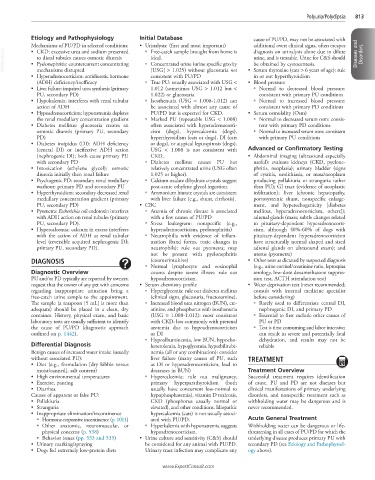Page 1613 - Cote clinical veterinary advisor dogs and cats 4th
P. 1613
Polyuria/Polydipsia 813
Etiology and Pathophysiology Initial Database cause of PU/PD, may not be associated with
Mechanisms of PU/PD in selected conditions: • Urinalysis: (first and most important) additional overt clinical signs, often escapes
VetBooks.ir • Pyelonephritis: countercurrent concentrating ○ Concentrated urine (urine specific gravity urine, and is treatable. Urine for C&S should Diseases and Disorders
• CKD: excessive urea and sodium presented
○ Free-catch sample brought from home is
diagnosis on urinalysis alone due to dilute
to distal tubules causes osmotic diuresis
ideal.
be obtained by cystocentesis.
mechanisms disrupted
in or out hyperthyroidism
consistent with PU/PD
• Hyperadrenocorticism: antidiuretic hormone [USG] > 1.025) without glucosuria not • Serum thyroxine (cats > 6 years of age): rule
(ADH) deficiency/inefficacy ○ True PU: usually associated with USG < • Blood pressure
• Liver failure: impaired urea synthesis (primary 1.012 (sometimes USG > 1.012 but < ○ Normal to decreased blood pressure:
PU, secondary PD) 1.022) or glucosuria consistent with primary PU conditions
• Hypokalemia: interferes with renal tubular ○ Isosthenuria (USG = 1.008-1.012) can ○ Normal to increased blood pressure:
action of ADH be associated with almost any cause of consistent with primary PD conditions
• Hypoadrenocorticism: hyponatremia depletes PU/PD but is expected for CKD. • Serum osmolality (Osm)
the renal medullary concentration gradient ○ Marked PU (repeatable USG < 1.008) ○ Normal to decreased serum osm: consis-
• Diabetes mellitus: glucosuria creates an often associated with hyperadrenocorti- tent with primary PD conditions
osmotic diuresis (primary PU, secondary cism (dogs), hypercalcemia (dogs), ○ Normal to increased serum osm: consistent
PD) hyperthyroidism (cats or dogs), DI (cats with primary PU conditions
• Diabetes insipidus (DI): ADH deficiency or dogs), or atypical leptospirosis (dogs).
(central DI) or ineffective ADH action USG < 1.008 is not consistent with Advanced or Confirmatory Testing
(nephrogenic DI); both cause primary PU CKD. • Abdominal imaging (ultrasound especially
with secondary PD ○ Diabetes mellitus causes PU but useful): evaluate kidneys (CKD, pyelone-
• Intoxication (ethylene glycol): osmotic relatively concentrated urine (USG often phritis, neoplasia); urinary bladder (signs
diuresis initially then renal failure 1.025 or higher). of cystitis, urolithiasis, or mass/neoplasm
• Psychogenic PD: secondary renal medullary ○ Calcium oxalate dihydrate crystals suggest producing pollakiuria or stranguria rather
washout: primary PD and secondary PU post-acute ethylene glycol ingestion. than PU); GI tract (evidence of neoplastic
• Hyperthyroidism: secondary decreased renal ○ Ammonium biurate crystals are consistent infiltration); liver (chronic hepatopathy,
medullary concentration gradient (primary with liver failure (e.g., shunt, cirrhosis). portosystemic shunt, nonspecific enlarge-
PU, secondary PD) • CBC ment, and hyperechogenicity [diabetes
• Pyometra: Escherichia coli endotoxin interferes ○ Anemia of chronic disease is associated mellitus, hyperadrenocorticism, others]);
with ADH action on renal tubules (primary with a few causes of PU/PD adrenal glands (mass; subtle changes related
PU, secondary PD). ○ Stress leukogram: nonspecific (e.g., to pituitary-dependent hyperadrenocorti-
• Hypercalcemia: calcium in excess interferes hyperadrenocorticism, pyelonephritis) cism, although 40%-60% of dogs with
with the action of ADH at renal tubular ○ Neutrophilia with evidence of inflam- pituitary-dependent hyperadrenocorticism
level (reversible acquired nephrogenic DI; mation (band forms, toxic changes in have structurally normal shaped and sized
primary PU, secondary PD). neutrophils): rule out pyometra; may adrenal glands on ultrasound exam); and
not be present with pyelonephritis uterus (pyometra)
DIAGNOSIS (counterintuitive) • Other tests as dictated by suspected diagnosis
○ Normal lymphocyte and eosinophil (e.g., urine cortisol/creatinine ratio, leptospira
Diagnostic Overview counts despite severe illness: rule out serology, low-dose dexamethasone suppres-
PU and/or PD typically are reported by owners; hypoadrenocorticism. sion test, ACTH stimulation test)
request that the owner of any pet with concerns • Serum chemistry profile • Water deprivation test (never recommended;
regarding inappropriate urination bring a ○ Hyperglycemia: rule out diabetes mellitus consult with internal medicine specialist
free-catch urine sample to the appointment. (clinical signs, glucosuria, fructosamine). before considering)
The sample (a teaspoon [5 mL] is more than ○ Increased blood urea nitrogen (BUN), cre- ○ Rarely used to differentiate central DI,
adequate) should be placed in a clean, dry atinine, and phosphorus with isosthenuria nephrogenic DI, and primary PD
container. History, physical exam, and basic (USG = 1.008-1.012): most consistent ○ Essential to first exclude other causes of
laboratory tests are usually sufficient to identify with CKD; less commonly with prerenal PU or PD
the cause of PU/PD (diagnostic approach azotemia due to hypoadrenocorticism ○ Test is time consuming and labor intensive;
outlined on p. 1442). or DI can result in severe and potentially fatal
○ Hypoalbuminemia, low BUN, hypocho- dehydration, and results may not be
Differential Diagnosis lesterolemia, hypoglycemia, hyperbilirubi- reliable
Benign causes of increased water intake (usually nemia (all or any combination): consider
without associated PU): liver failure (many causes of PU, such TREATMENT
• Diet (e.g., formulation [dry kibble versus as DI or hyperadrenocorticism, lead to
moist/canned], salt content) decreases in BUN) Treatment Overview
• High environmental temperatures ○ Hypercalcemia: rule out malignancy, Successful treatment requires identification
• Exercise, panting primary hyperparathyroidism (both of cause. PU and PD are not diseases but
• Diarrhea usually have concurrent low-normal to clinical manifestations of primary underlying
Causes of apparent or false PU: hypophosphatemia), vitamin D toxicosis, disorders, and nonspecific treatment such as
• Pollakiuria CKD (phosphorus usually normal or withholding water may be dangerous and is
• Stranguria elevated), and other conditions. Idiopathic never recommended.
• Inappropriate elimination/incontinence hypercalcemia (cats) is not usually associ-
○ Hormone-responsive incontinence (p. 1011) ated with PU/PD. Acute General Treatment
○ Other anatomic, neuromuscular, or ○ Hyperkalemia with hyponatremia suggests Withholding water can be dangerous or life-
physical concerns (p. 538) hypoadrenocorticism. threatening in all cases of PU/PD for which the
○ Behavior issues (pp. 533 and 535) • Urine culture and sensitivity (C&S) should underlying disease produces primary PU with
• Urinary marking/spraying be considered for any animal with PU/PD. secondary PD (see Etiology and Pathophysiol-
• Dogs fed extremely low-protein diets Urinary tract infection may complicate any ogy above).
www.ExpertConsult.com

